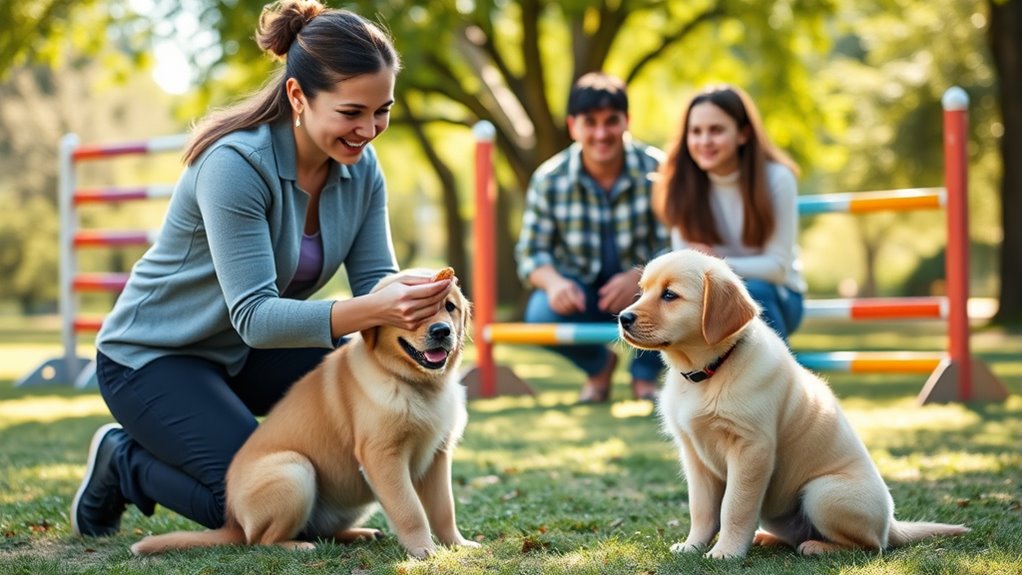To help your adopted rescue dog adjust, focus on consistent routines and gentle socialization. Use positive reinforcement to reward calm behavior and gradually introduce new environments and experiences. Be patient, stay clear with commands, and observe your dog’s body language to prevent overwhelm. Building trust takes time, but with patience and perseverance, your dog will gain confidence and feel secure. Keep going, as the next steps will guide you through fostering a happy, well-adjusted companion.
Key Takeaways
- Establish a consistent routine for feeding, walks, and play to create a sense of security.
- Use positive reinforcement to reward calm behavior and build confidence in the new environment.
- Gradually introduce the dog to new experiences and social settings, observing body language for signs of comfort.
- Address behavioral issues with patience and gentle behavior modification techniques tailored to the dog’s needs.
- Consult a professional trainer or behaviorist for personalized guidance and effective training strategies.

Training rescue dogs requires patience, consistency, and a clear approach. When you bring a rescue dog into your home, you’re helping them transition from uncertain surroundings to a trusting, well-adjusted member of your family. A key part of this process involves behavior modification, which targets problematic behaviors and encourages positive ones. You’ll want to start by understanding your dog’s specific needs and triggers. For example, if your dog shows signs of fear or aggression, your goal is to gradually change their emotional response through gentle, consistent reinforcement. Behavior modification techniques, such as rewarding calm behavior and avoiding punishment, help your dog build confidence and establish a sense of safety. This approach not only discourages undesirable behaviors but also fosters a stronger bond between you and your dog.
Patience and consistency are key to successfully modifying behavior in rescue dogs.
Socialization techniques are equally essential, especially for rescue dogs who may have limited exposure to new people, animals, or environments. You should introduce your dog to new experiences gradually and in a controlled manner. Start with small, positive interactions, like meeting calm, friendly people or other dogs that you trust. Use treats and praise to reinforce good behavior during these encounters. Over time, these socialization efforts help your dog become more comfortable and confident in various settings. Remember, every rescue dog is different; some may need more time and gentle exposure to new stimuli. Patience is vital, and rushing the process can set back progress. Keep interactions short and positive, and always observe your dog’s body language to ensure they’re not overwhelmed. Additionally, consulting with a professional dog trainer or behaviorist can provide personalized guidance for your dog’s unique needs.
Consistency is the backbone of successful training. Establish a routine that your dog can rely on, including regular feeding times, walks, and play sessions. Consistent commands and cues also help your rescue dog understand what’s expected of them. Use the same words and gestures during training to avoid confusion. Reinforce desirable behaviors immediately with praise or treats, and redirect or ignore unwanted behaviors when they occur. This consistency helps your dog learn faster and feel more secure in their new environment.
Combining behavior modification with socialization techniques creates a thorough approach that addresses both behavioral issues and confidence-building. Your dedication to these methods will pay off as your rescue dog begins to adapt and thrive in their new home. Remember, patience and perseverance are your best tools; with time and reliability, you’ll see your rescue dog transform into a happy, well-adjusted companion.
Frequently Asked Questions
How Long Does It Typically Take for a Rescue Dog to Settle In?
It typically takes rescue dogs about a few weeks to a few months to settle in fully. During this time, focus on house training and socialization techniques to help your dog feel secure. Consistent routines and positive reinforcement speed up the process. Be patient, as each dog adjusts at its own pace. With time and care, your rescue dog will become comfortable and happy in their new home.
What Are Signs of Stress or Anxiety in Newly Adopted Rescue Dogs?
You might think your rescue dog’s just being shy, but signs of stress or anxiety show in subtle body language like tucked tails, flattened ears, or avoiding eye contact. Vocalizations such as whining, barking, or growling also reveal discomfort. Ironically, these signals often go unnoticed, yet they’re your dog’s way of telling you they’re overwhelmed. Recognize these cues early, and you’ll help ease their adaptation into a calm, trusting new home.
How Can I Prevent My Rescue Dog From Developing Separation Anxiety?
To prevent your rescue dog from developing separation anxiety, start crate training early to create a safe space. Use scent familiarization by leaving its bedding or a worn item when you’re away, helping it feel secure. Gradually increase alone time, rewarding calm behavior. Keep goodbyes low-key, and make certain your dog has plenty of mental and physical stimulation. Consistency and patience will build your dog’s confidence and ease its shift into independence.
Are There Specific Training Methods for Rescue Dogs With Trauma Histories?
You should use trauma-informed training and gentle handling techniques to help your rescue dog with a trauma history. Focus on creating a calm, predictable environment, and build trust through patience and positive reinforcement. Avoid force or harsh commands, and gradually introduce new experiences at your dog’s pace. Consistency, empathy, and understanding are key to helping your rescue dog feel safe and secure as they adjust.
How Do I Introduce My Rescue Dog to Other Pets Safely?
You should start with slow feline introductions, using a secure barrier like a baby gate, so your rescue dog can observe without direct contact. Practice leash training to keep control during initial meetings, ensuring safety for all pets. Gradually increase supervised interactions, rewarding calm behavior. Patience is key; let your rescue dog build trust and comfort at their own pace, creating positive associations with your other pets.
Conclusion
Training rescue dogs helps them feel safe and confident in their new homes. For example, imagine adopting a nervous dog who slowly learns to trust you through patience and positive reinforcement. Over time, you’ll see them wagging their tail and cuddling on the couch. Remember, your consistent effort creates a bond that transforms a scared rescue into a happy, well-adjusted companion. Your dedication makes all the difference in their journey to a new life.









